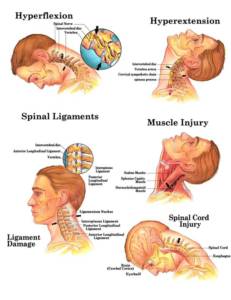Whiplash
Whiplash is an acceleration-deceleration injury to the head and neck. Often whiplash can happen from motor vehicle accidents or other activities, like wrestling and other impactful sports. It can cause headaches, necks stiffness, headaches to temples and eyes. Some people experience pain and ringing in ears (tinnitus), headaches to back side of head, and migraines.
Sometimes the cervical spine disks, in your neck can be injured, but thankfully not always. Sometimes it’s just the muscle and ligament injuries or strains which are much easier to recover from.
What Happens?

Whiplash Portrayal
This type of injury most often happens in the event of a rear end collision. Hyper flexion and than hyper extension in the neck occurs when lets say a car hits the victims car in rear- the seatbelt holds our torso but not the neck.
At the time of injury our body goes into the Acute – Protection Phase of the Stages of Healing. In the acute phase our body’s aim is to protect the injury from further damage. Swelling is at a peak during this phase and symptoms/full extent of injury may not be clear for the first 24-72 hours. This phase usually last a couple of days depending on the severity of injury.
Besides the physical injury of a mechanical impact there is emotional consequences to whiplash. In the event of a rear impact accident can be very traumatic firing our Sympathetic Nervous System. Also known as the Fight or Flight response, which is an acute response to stress. During this process the chemicals like adrenaline, noradrenaline, and cortisol releases into our bloodstream. Our respiratory rate increases, blood is shunted away from our digestive tract and directed to our muscles switch are requiring more energy, our awareness intensifies and our perception of pain diminishes.
Symptoms Of A Whiplash
- The symptoms are as follows: neck pain 92%, headache 57%, 56%, shoulder pain 49%, anxiety 44%, interscapular pain 42%.
- There are also other symptoms, slightly less frequent, that are often not associated with whiplash. These include low back pain at 39%, sleep disturbance at 39%, upper limb peers these jets or pins and needles at 30%, sensitivity to noise shows 29% of people having whiplash feel sensitive to noise
- Other symptoms include impaired concentration experienced by 26% of the whiplash people, blurred vision experienced by 21%, irritability 21%. Dysphasia or difficulty in swallowing at 16%, dizziness at 15%, forgetfulness at 15%, upper limb pain- 12%. Upper limb weakness patients usually seen around 6% of the total, ringing in the ears also known as tinnitus at 4% and jaw and facial pain or TMJ pain at four or more percent.
Exercises you can do for this condition: https://www.spineuniverse.com/conditions/whiplash/video-series-exercises-whiplash
-Jolita Brilliant. Licensed Massage Therapist, Burlington, Vermont


